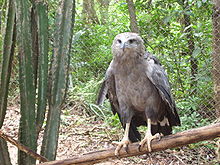Chaco eagle
| Chaco eagle | |
|---|---|
 |
|
| Scientific classification | |
| Kingdom: | Animalia |
| Phylum: | Chordata |
| Class: | Aves |
| Order: | Falconiformes (or Accipitriformes, q.v.) |
| Family: | Accipitridae |
| Genus: | Buteogallus |
| Species: | B. coronatus |
| Binomial name | |
|
Buteogallus coronatus (Vieillot, 1817) |
|
| Synonyms | |
|
Harpyhaliaetus coronatus |
|
Harpyhaliaetus coronatus
The Chaco eagle or crowned solitary eagle (Buteogallus coronatus), typically known simply as the crowned eagle (leading to potential confusion with the African Stephanoaetus coronatus) is an endangered bird of prey from eastern and central South America. This is a large raptor with a length of 73–79 cm (28.5–31 in), a wingspan of 170–183 cm (67–72 in) and an average weight of 2.95 kg (6.5 lb) Adults are almost entirely gray with a large occipital crest and a short, black-and-white-banded tail. The juvenile is gray-brown on the back and pale with gray-brown streaks on the head and underside.
The Chaco eagle lives in Argentina, Brazil, Paraguay and Bolivia. It tends to live in open woodland and marshland, unlike its closest relative, the montane solitary eagle, which lives only in dense mountain forest. It is often noted for its sluggish movements during the day and is believed to be largely crepuscular in activity. It preys principally on mammals, including armadillos, skunks, weasels, rodents and monkeys. It also hunts reptiles (principally snakes), fish, domestic lambs and occasionally birds, including tinamou and poultry.
Found in large trees, the nest of this species is large platform of sticks about 1.2 m (3.9 ft) across and 30 cm (12 in) deep. One nest was noted to be at the top of a tree that also contained a communal nest of monk parakeets. Eggs were recorded in October and young in May but nothing more is really known about its breeding activities, except that they lay only one egg per reproductive cycle. This species is considered endangered by BirdLife International, mainly because it occurs at very low density and it is very seldom encountered in the wild. It is largely threatened by habitat destruction, since its native habitat has been greatly compromised by the spread of agriculture and cattle ranching. Also, this bird is sometimes shot and trapped, practices believed to occur mainly due to fear of livestock predation (Sarasola, Santillán, and Galmes 2010).
...
Wikipedia

